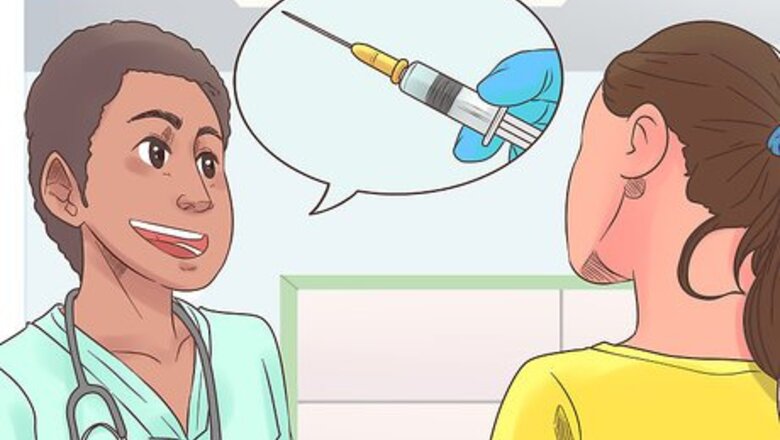
views
- Give your puppy their first round of vaccines between 6 to 12 weeks of age and administer boosters every 3 weeks until they’re 16 weeks old.
- Fill a needle full of the vial of liquid diluent and release it into the powder vial. Shake the vial for 2-3 minutes then fill a new syringe with the vaccine.
- Lay your puppy down and raise the skin slightly on their neck or thigh (depending on the vaccine). Check for blood from a vein, then press the plunger down.
Creating a Vaccination Plan
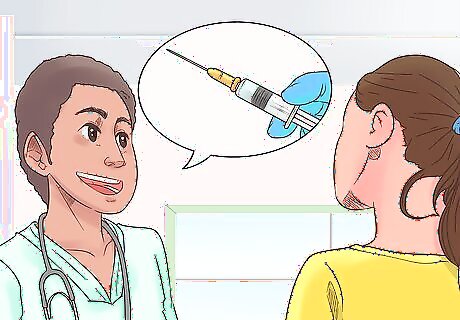
Talk with your veterinarian. Not all dogs are good candidates for home vaccination. Call or meet with your vet to determine if your dog meets the basic health criteria. If you are concerned about how to give the shots, your vet can also talk you through the process or even let you watch a demonstration in-office. Vets technically lose money by having you home vaccinate. However, most are more than happy to help you learn if it is in the best interest of your puppy. You'll also want to check the laws for your area regarding animal vaccinations. Some locations do not recognize self-administered rabies vaccinations and may even issue fines.
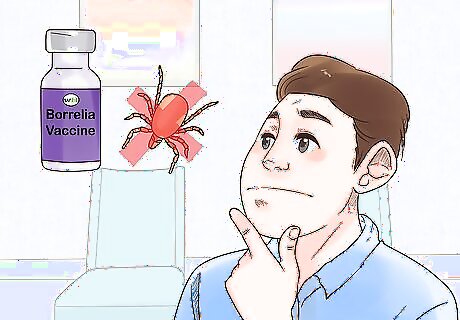
Decide which non-core vaccinations to give. Veterinarians generally recognize certain vaccinations as central or “core” to your puppy's health, such as rabies and parvovirus. Other vaccinations can be helpful for puppies in certain environments. Leptospirosis, coronavirus, bordetella, and borrelia burgdorferi are all optional vaccines. For example, if you live in a wooded area where your puppy may be exposed to ticks, then a borrelia vaccine is a good idea as it reduces the risk of Lyme Disease. It's a good idea to consult your local veterinarian if you're not sure which non-core vaccinations are right for your dog. They'll be able to give you an idea of what shots are necessary and which shots you can skip out on.
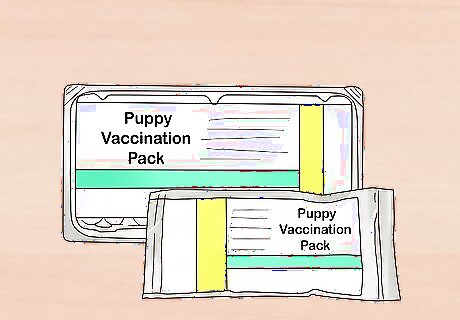
Purchase a puppy vaccination pack. These packets contain all of the vaccination materials from needles to vials for the full series of puppy shots. Feed store owners, specialty pet stores, and online pet outlets may carry the shot packets. Only get your vaccines from reputable retailers or they could be worthless or even cause harm to your puppy. Expect to pay somewhere between $75-100 for a full series of puppy vaccinations. Before you buy a vaccination pack, ask the vendor how they store the packs before they're purchased. Avoid buying packs that have been stored in excessive heat or cold or the vaccinations might not be as effective.
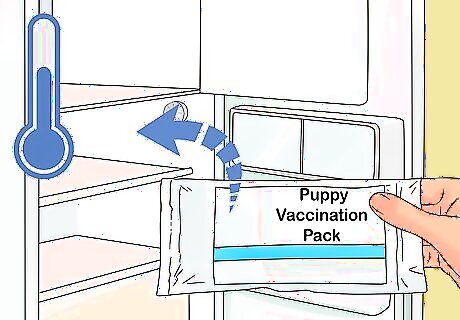
Keep the shots cold. As soon as you get the vaccines, place them in the drawer of your refrigerator. If you buy online, the company should also ship your shots in a cold container. Some companies will even require that you pay extra for overnight shipping. If the shots drop below a certain temperature, they may become less effective.
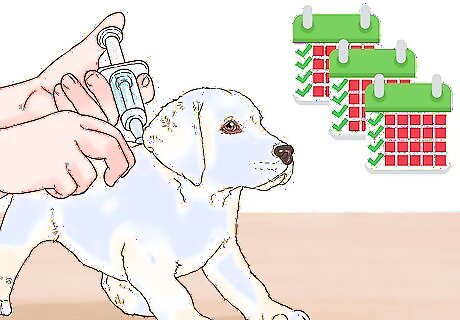
Give the first combination vaccine between 6 to 12 weeks of age. To reduce the total number of shots for puppies, between 3 to 5 viruses are usually combined into a single dosage. Your puppy should receive this first major shot fairly early on, so that there is enough time for boosters before they mature. A standard first-round combination vaccine may container parvovirus, parainfluenza, adenovirus, and distemper. If your puppy has been exposed to some of these illnesses early in life, your vet may recommend that you vaccinate as soon as possible.
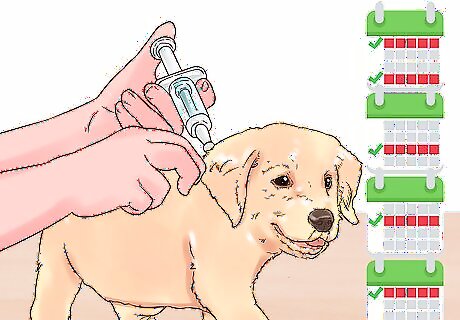
Give boosters every 3 weeks until 16 weeks of age. The vaccination packet that your purchase will provide instructions regarding the frequency of each shot and what they each contain. Distemper, for example, requires an initial shot and a series of boosters thereafter. Not giving the boosters or delaying them reduces or eliminates any protections for your puppy.

Do not alter the injection amounts. The manufacturer of the shots will provide specific dosage instructions on or in the vaccination package. Read these instructions carefully and do not alter them to fit your puppy's age, weight, or breed. Large puppies should get the same dose of vaccine as small ones and vice versa.
Getting Ready to Inject

Make sure your puppy is healthy before you vaccinate them. Vaccinating your puppy when they're sick will prevent the vaccines from working properly. If your puppy shows signs of being sick, take them to the vet and wait until they're healthy again to administer the vaccinations.
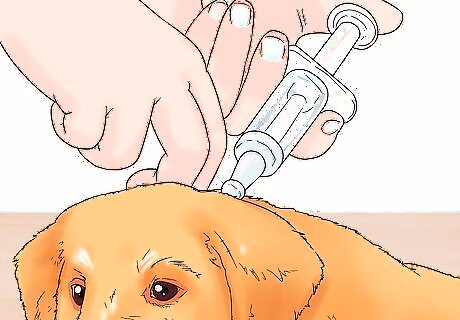
Plan to inject in your puppy's neck for subcutaneous shots. When you receive your shot kit, you'll notice that each of the shots will be labeled according to the preferred injection site. For shots that need to be injected subcutaneously (under the skin's surface), it's usually easiest to use the back of your puppy's neck as the injection site, as it contains a fair amount of extra skin.
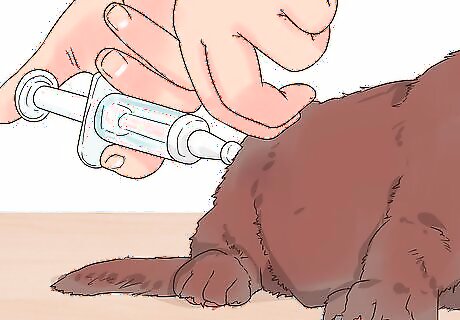
Plan to inject in your puppy's thigh for intramuscular shots. Identify those shots in the kit that are labeled “intramuscular” or that require an injection directly into muscle tissue. For these shots, the best choice is usually your puppy's upper thigh because the muscle lies close to the skin's surface. Vaccines rarely require intramuscular injection, and it can be more painful for your puppy. Read the instructions on your vaccines carefully, and inject vaccines subcutaneously whenever possible.
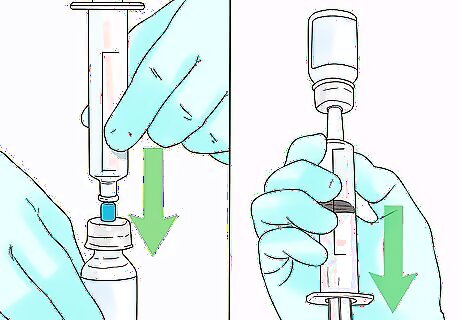
Fill up the syringe from the diluent vial. Remove the protective cap from the syringe. Push the needle into the top opening of the vial of liquid diluent. Draw the liquid up into the syringe until it reaches the suggested limit. The liquid diluent helps to break up the powder of the vaccine, so it's important to measure this exactly.
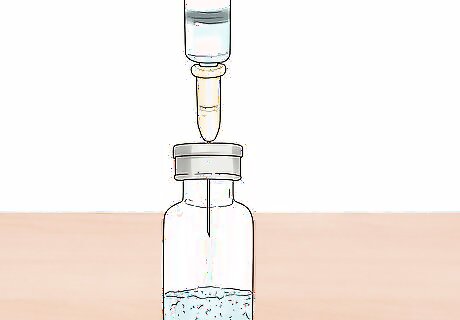
Release the vial liquid into the powder vial. Position the syringe over the vial with the powder inside. Push the needle into the top opening. Then, press down on the plunger until all of the liquid is pushed into the powder vial. Slowly pull out the syringe.
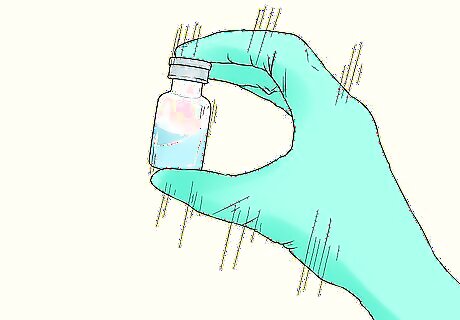
Shake the vial. Grasp the powder vial with the liquid added. Hold it firmly with your fingers and gently shake it for 2-3 minutes. Look inside the vial to see if there is any powder visible. If so, keep going until it is fully dissolved.
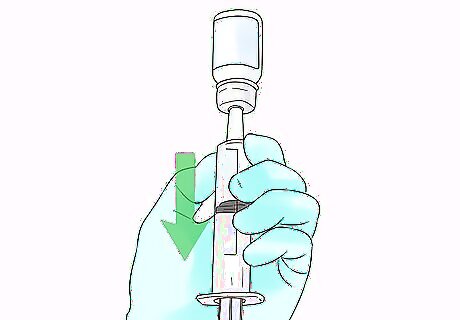
Pull up the mixture into the syringe. Set the newly shaken vial onto a firm surface. Get a new syringe and remove the protective top. Push the tip into the vial. Pull up the plunger until the syringe is filled to the right level with the vaccine. Set the vaccine aside in a safe location where it is reachable, but won't roll off.
Giving the Injection
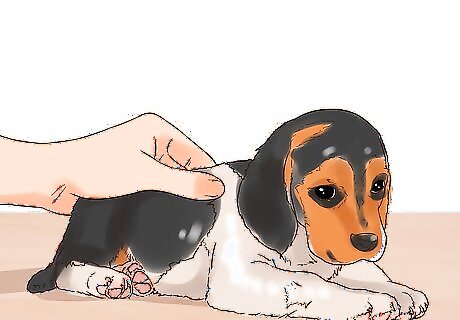
Position the puppy laying down. Either set the puppy on the ground or lift them on to a sturdy table. Use your non-dominant hand to hold them still by gently grasping the scruff at the back of their neck. You can also tuck them slightly under your arm and exert a little bit of downward pressure to hold them in position. Some puppies behave better when placed on a high table for shots. However, you must keep a secure grip on them at all times. Or, they could fall to the ground and be injured. Ask a friend to assist you with the injections. You can also place the puppy on the table and then use your upper body weight to securely pin them down.
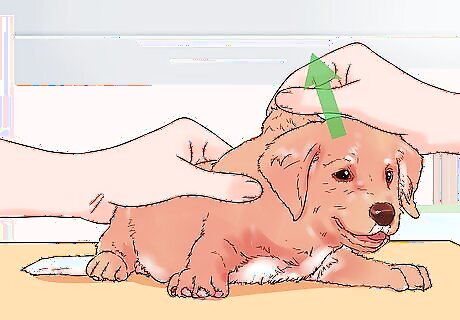
Raise the skin slightly up. Continuing to hold the puppy in position, move your fingers to the injection site. Grasp the puppy's loose skin and fur and pull slightly upwards. If you are injecting behind the neck, then you'll pull up a good amount of skin. For the thigh, the skin won't be as much, which is okay since you are injecting into the muscle anyway. Once you've practiced lifting up the skin, wipe down the area with an alcohol wipe or a cotton ball dipped in alcohol. It's okay if you get some alcohol on the fur as well.
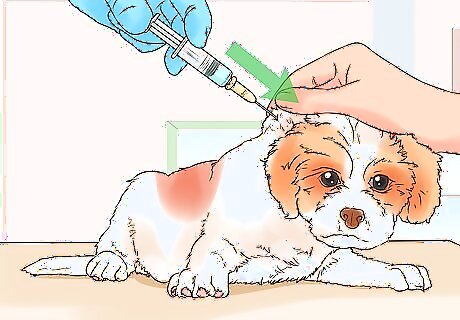
Slide the needle tip into the skin. Grasping the syringe firmly in one hand, separate your dog's fur with your free hand. Set the needle against the raised skin and push it gently inside. If you are injecting the neck, keep the skin raised. If you are injecting the thigh, release the skin as the needle starts to enter.
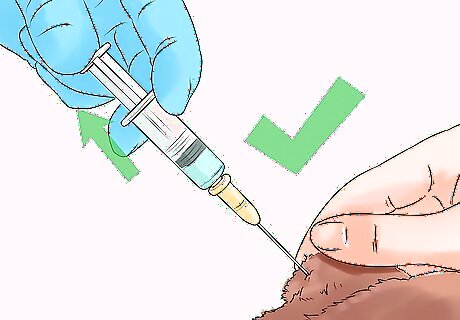
Check for a vein hit. Once the needle is in place, pull back on the syringe's plunger just a very small amount. Look to see if any blood drained into the syringe. If this happens, then your needle might have hit a vein. Pull the entire needle out and re-insert in once more with a slightly different angle. Inserting vaccination medication directly into a vein creates more of a risk of a reaction on the part of your puppy.
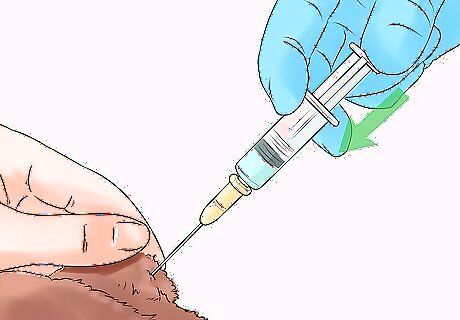
Push the syringe plunger down. After you've verified that the needle is in a good position, apply steady pressure at the end of the plunger. Go slowly and don't rush this step. Continue until the syringe is empty and the vaccine is fully injected. Pull the needle out of the skin. Once you are done, carefully dispose of the needle in the sharps container provided within the kit. If your kit doesn't include a sharps container, then place cap the used needle and place it in a sealed, hard plastic container for disposal.
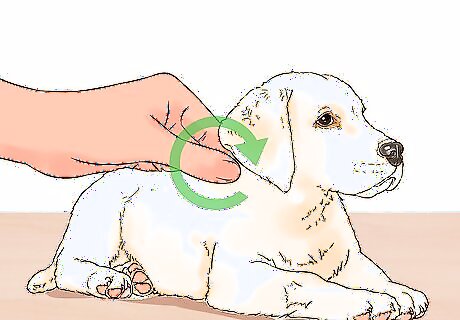
Massage the site. The injection might leave a little bump in your dog's skin. This is just from the liquid sitting under the skin's surface and doesn't mean that anything is wrong. To make your puppy feel better, take 2 fingers and gently rub this area for 30 seconds or so.
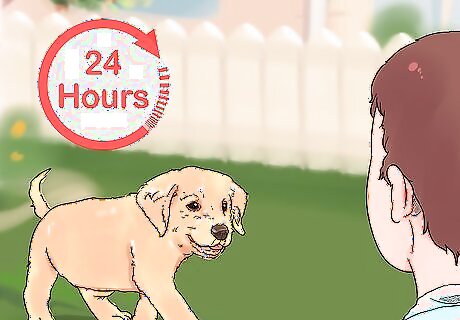
Monitor your puppy for an allergic reaction for 24 hours. Most puppies experience no reaction to their vaccinations whether they are given them at home or in a vet's office. However, some puppies do experience mild reactions, such as loose stools or a loss of appetite. Other puppies have a more severe reaction characterized by difficulty breathing, heavy panting, and loss of consciousness. If you are worried about your puppy, take them to an emergency vet immediately. Vaccines can come with a risk of anaphylactic shock. If your dog shows signs of experiencing anaphylactic shock, including vomiting, diarrhea, shock, seizure, cold limbs, or pale gums, take them to an emergency vet immediately.



















Comments
0 comment